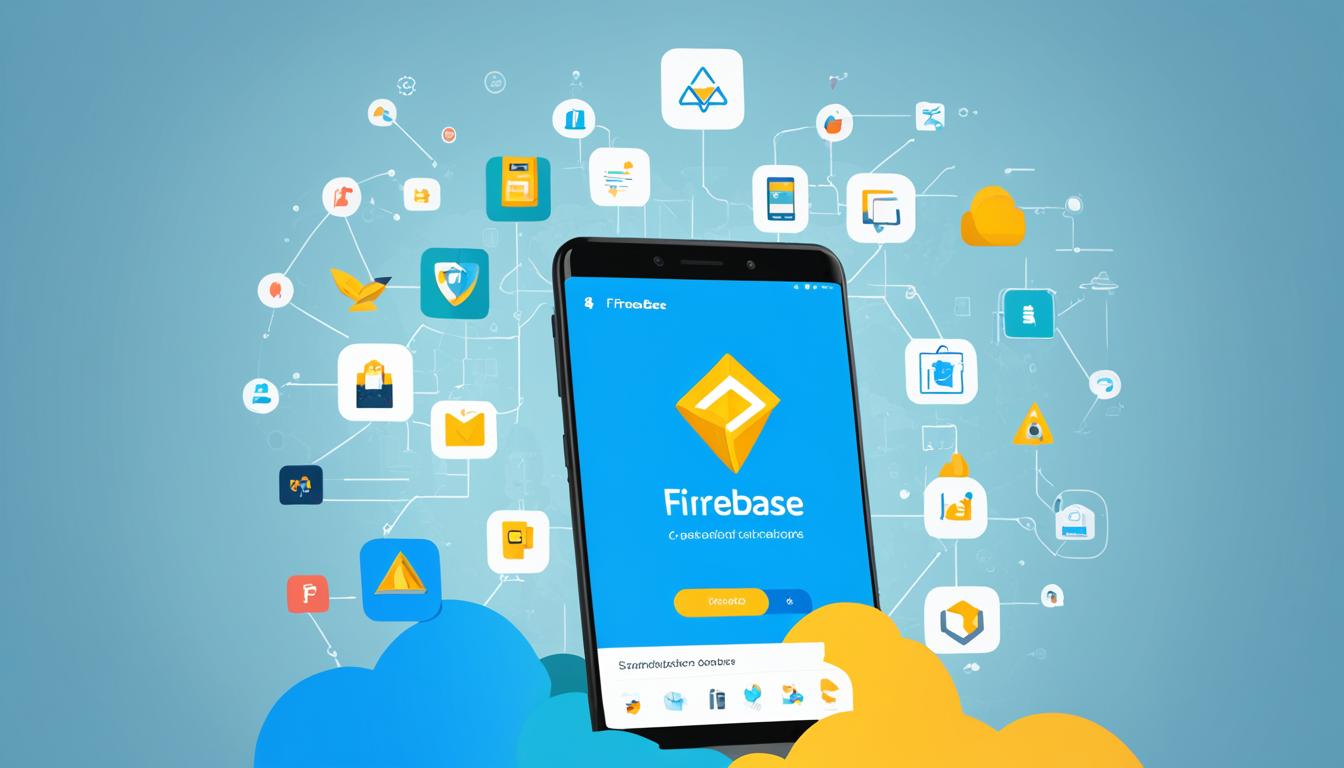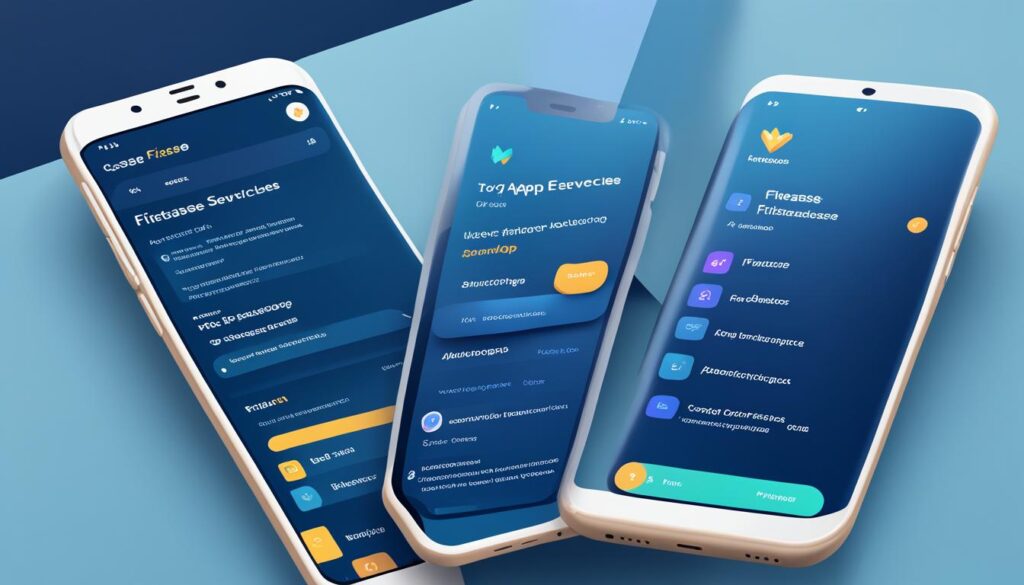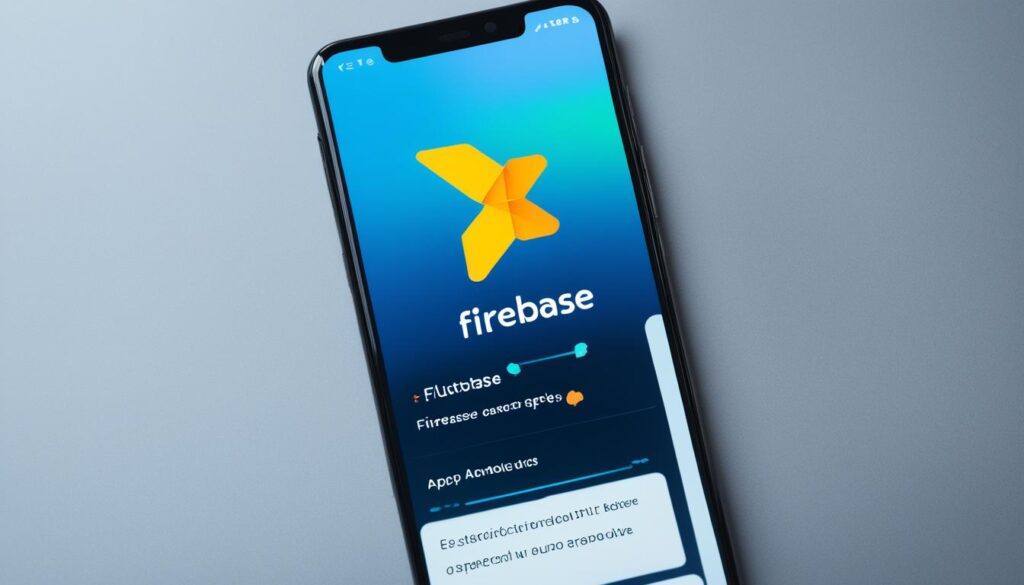In the world of mobile app development, combining Firebase and Flutter has changed the game. This guide will show you how to link Firebase with Flutter. By doing this, developers can use Firebase’s many services to make apps that are both rich in features and engaging.
This guide will cover important steps and tips for using Firebase with Flutter. It’s great for both experienced developers and those just starting out. You’ll learn how to use Firebase in Flutter projects and make apps that users love.
Table of Contents
Key Takeaways
- Learn how Firebase and Flutter work together in mobile app development.
- Find out how to set up Firebase for Flutter, including installation and using Firebase services.
- See how to add Firebase Authentication, Cloud Firestore, and other services to Flutter apps.
- Discover tips for handling data in real-time, setting up security, and improving app performance with Firebase.
- Learn about deploying and hosting Flutter apps with Firebase for easy distribution and upkeep.
Introduction to Firebase and Flutter
In the world of app development, Firebase and Flutter have changed the game. They make building apps easier, faster, and more visually appealing. These tools help developers create apps that are strong, grow well, and look great.
What is Firebase?
Firebase is a top application development platform. It gives developers tools and services to make building apps easier. You get real-time database management, user sign-ins, cloud storage, and cloud messaging all in one place.
What is Flutter?
Flutter is a cross-platform mobile framework by Google. It lets developers make apps for both iOS and Android that run fast and look great. With its easy UI development and lots of customizable widgets, developers can make apps that stand out.
When you use Firebase with Flutter, you get the best of both worlds. This combo means you can make apps fast, manage data well, and give users a smooth experience. It’s why many developers choose this combo for their apps.
“The integration of Firebase and Flutter is a game-changer for mobile app development, offering developers a comprehensive and efficient solution to build, deploy, and manage their applications.”
Setting up Firebase for Flutter Development
Adding Firebase to your Flutter project is easy with a few steps. First, you need to set up a Firebase project and make your Flutter app work with it. This means installing the Firebase SDKs and setting up connections.
To start, here’s what you should do:
- Create a new Firebase project in the Firebase console and turn on the services you want, like Firebase Authentication, Cloud Firestore, and more.
- Download the Firebase configuration file (google-services.json for Android or GoogleService-Info.plist for iOS) and put it in your Flutter project.
- Put the Firebase SDK packages in your Flutter project by following the Firebase guide.
- Start the Firebase services you want in your Flutter app’s main.dart file.
After setting up your Firebase project and adding the SDKs, your Flutter app will connect well with Firebase’s tools and services. This lets you use Firebase’s features, like authentication, real-time database, and cloud storage, in your Flutter app.
“Firebase gives you a bunch of tools and services that can make making and launching your Flutter app faster.”
Once you’ve set everything up, you’re ready to add Firebase services to your app. Next, we’ll see how to add Firebase Authentication, Cloud Firestore, and other important features to your Flutter app.
Integrating Firebase with Flutter
As a Flutter developer, adding Firebase services to your apps opens up a lot of powerful features. We’ll look at two key Firebase services: Authentication and Cloud Firestore. We’ll see how to easily add them to your Flutter apps.
Integrating Firebase Authentication
Firebase Authentication makes it easy and secure to handle user login in your Flutter app. With a few lines of code, you can use email, Google, Facebook, and more to sign in. Adding firebase authentication integration with flutter makes logging in smooth, keeps data safe, and makes users happy.
Integrating Firebase Cloud Firestore
Firebase Cloud Firestore is a great, flexible NoSQL database for your Flutter apps. With firebase cloud firestore integration with flutter, you can easily save and get user data. It also helps with real-time updates and powerful queries for your apps. This is key for firebase services integration in flutter apps.
| Firebase Service | Key Benefits |
|---|---|
| Authentication |
|
| Cloud Firestore |
|
Learning to use these Firebase services with your Flutter app lets you make apps that are strong, grow with your needs, and give users a great experience.
Integrating Firebase with Flutter
As you dive into flutter development, you’ll see how great Firebase is for your apps. This combo brings lots of new features to your Flutter projects. It makes your apps better for users and more powerful.
Firebase offers authentication, real-time data synchronization, secure file storage, and cloud messaging. These services can make your Flutter apps better in many ways. We’ll show you how to use Firebase to make your apps more feature-rich, efficient, and secure.
- Integrating Firebase Authentication for secure user management
- Utilizing Firebase Cloud Firestore for real-time data synchronization
- Harnessing the power of Firebase Realtime Database for efficient data handling
- Implementing Firebase Cloud Storage for secure file uploads and retrieval
- Leveraging Firebase Cloud Messaging for push notifications and in-app messaging
Adding Firebase services to your Flutter apps brings new features. This makes your apps more engaging and full of features. Start exploring the many ways firebase integration with flutter can help your app development.
“The integration of Firebase with Flutter is a game-changer, empowering developers to create powerful, scalable, and feature-rich applications with ease.”
Handling Real-Time Data with Firebase Realtime Database
As a developer making Flutter apps, you often need to work with real-time data. This means updates must happen instantly and be synced across many clients. The Firebase Realtime Database is perfect for this, offering a cloud-hosted NoSQL database. It makes handling real-time data in Flutter apps easy.
Understanding Firebase Realtime Database
The Firebase Realtime Database is a NoSQL, JSON-based database. It keeps data in sync across connected clients in real-time. Unlike old databases, it doesn’t need polling or manual refreshes. Instead, it uses WebSockets to push updates instantly, keeping your app’s data fresh.
This makes it great for building apps that need real-time data exchange. It’s perfect for collaborative apps, chat features, and more.
Here are some key features of the Firebase Realtime Database for real-time data handling in Flutter apps with firebase:
- Easy firebase realtime database integration with flutter thanks to a dedicated SDK
- Offline support, so your app works even without internet, and syncs automatically when online
- Firebase realtime database features like security rules, data validation, and access control for data safety
- Scalable and reliable infrastructure, supported by Google’s global network and cloud services
Using the Firebase Realtime Database lets you create Flutter apps with a real-time user experience. Your apps will have smooth data synchronization and offline use. This powerful NoSQL database is key to combining Firebase with Flutter. It helps developers make mobile apps that are scalable and full of features.
Firebase Cloud Storage Integration
Adding Firebase Cloud Storage to your Flutter apps is a big step forward. This service from Google is great for storing files securely and efficiently. It’s perfect for your Flutter projects.
Uploading Files to Firebase Storage
With Firebase Cloud Storage, uploading files like images, documents, or videos is easy. Your Flutter app can connect to this service for storing and getting files. This makes managing your app’s files simple and powerful.
- Set up your Flutter project to use Firebase Cloud Storage.
- Write code to send files from your app to Firebase Storage.
- Keep track of file details like names, sizes, and types for better organization.
Retrieving Files from Firebase Storage
Getting files from Firebase Cloud Storage is key for a smooth user experience in your Flutter app. This integration lets you easily get and show files in your app.
- Get file references and download them to your app.
- Use smart caching to make getting and showing files faster.
- Use Firebase Storage’s security to control who can see or access files.
| Firebase Storage Feature | Description |
|---|---|
| File Upload | Upload different files like images, documents, and videos easily to Firebase Storage. |
| File Retrieval | Get and download files from Firebase Storage to use in your Flutter app. |
| Security and Access Control | Use Firebase Storage’s strong security to manage who can see or access your files in the app. |
Adding Firebase Cloud Storage to your Flutter app brings many benefits. It makes handling files easier, improves the user experience, and keeps your app’s data safe.
“Firebase Cloud Storage provides a seamless and scalable solution for managing file storage in your Flutter applications, empowering you to focus on building amazing user experiences.”
Firebase Cloud Messaging for Push Notifications
When you start with Flutter development, adding Firebase Cloud Messaging (FCM) is key for sending push notifications. FCM helps you send updates and keep your users engaged. This makes your Flutter apps better for users.
FCM makes adding push notifications to your Flutter apps easy. It lets you quickly add push notification features. This keeps your users updated with the latest news from your app.
Implementing Push Notifications with Firebase Cloud Messaging
To start with push notifications in your Flutter apps using Firebase Cloud Messaging, follow these steps:
- Set up your Firebase project and enable the Firebase Cloud Messaging service.
- Integrate the Firebase SDK into your Flutter application, allowing it to communicate with the FCM service.
- Implement the necessary code to handle incoming push notifications, such as displaying them to the user or performing specific actions based on the notification content.
- Leverage the FCM API to send push notifications from your server-side application or backend, targeting specific users or devices.
Mastering Firebase Cloud Messaging with Flutter opens up many features. You can send real-time updates and engage users better. This combo of Flutter and Firebase Cloud Messaging makes apps more interactive and keeps users interested.
| Feature | Description |
|---|---|
| Targeted Messaging | Firebase Cloud Messaging lets you send push notifications to specific devices or groups of users. This ensures your messages go to the right people. |
| Real-Time Updates | FCM sends important info to your users right away. This keeps them up-to-date with your Flutter app. |
| Analytics and Reporting | Firebase gives you detailed analytics and reports. You can see how well your push notification campaigns are doing. |
Using Firebase Cloud Messaging in your Flutter apps makes for a smooth and engaging experience. It helps keep users coming back to your app.
Crash Reporting and Analytics with Firebase
As your Flutter app grows, making sure users have a smooth experience is key. Firebase’s Crash Reporting and Analytics can help you find and fix problems. They also give you insights into how your app is doing and what users like.
Setting up Crash Reporting
Adding Firebase Crash Reporting to your Flutter app is easy. With the Firebase SDK, you can track and analyze crashes. This helps you quickly find and fix bugs, making your app more stable.
Integrating Firebase Analytics
Firebase Analytics is great for understanding how your app is used. It tracks things like how engaged users are, what they buy, and how they find your app. This info helps you make smart choices to improve your app and grow your audience.
| Feature | Description |
|---|---|
| firebase crash reporting integration with flutter | Effortlessly capture and analyze crash reports to quickly identify and resolve issues, ensuring a stable and reliable app experience. |
| firebase analytics integration with flutter | Gain deep insights into user behavior, engagement, and in-app activities to optimize your app’s performance and drive growth. |
Using firebase crash reporting and analytics features for flutter apps can take your app to the next level. You’ll deliver a smooth and enjoyable experience that stands out.
Performance Monitoring with Firebase
When you start using Firebase with your Flutter apps, think about performance monitoring. Firebase has a great service called Firebase Performance Monitoring. It helps you track and improve your Flutter app’s performance. This ensures your app works smoothly and efficiently for users.
This service gives you insights into how your app performs. It helps you find and fix any slow spots. By using this, you can make your Flutter app run better. This makes your product better overall.
Key Features of Firebase Performance Monitoring for Flutter
- Firebase Performance Monitoring automatically collects important performance data. This includes app startup time, network request latency, and more. You don’t need to set it up manually.
- Real-time monitoring and alerts: The service keeps an eye on your app’s performance as it happens. This lets you quickly spot and fix any problems.
- It offers a detailed dashboard with lots of performance insights. This helps you figure out why your app might be slow.
- Working with Flutter is easy. Setting up and monitoring your app’s performance is straightforward.
Using firebase performance monitoring features for flutter development, you can find and fix slow parts of your app. This makes sure your Flutter apps work well and respond fast for users.
| Performance Metric | Description | Impact on User Experience |
|---|---|---|
| App Startup Time | The time it takes for your app to launch and become ready for user interaction. | Long startup times can make users unhappy and less likely to stick around. |
| Network Request Latency | The time it takes for your app to make network requests and get responses. | Slow network requests make your app seem slow and unresponsive. This can make users unhappy. |
| Page Load Time | The time it takes for your app’s pages or screens to load and show up. | Slow loading times can annoy users and might cause them to leave your app. |
By integrating firebase performance monitoring with flutter, you get important insights into your app’s performance. You can then take steps to make it better. This leads to a great user experience for your Flutter apps.
Security Rules and Best Practices
As developers, keeping our Flutter apps safe and private is key. This is especially true when using Firebase, a cloud platform with many services. Firebase security rules are vital for controlling who can see or change your app’s data and resources. They protect your users’ personal info.
Implementing Firebase Security Rules
Firebase security rules are like a set of rules written in code. They decide who can read, write, or change data in your Firebase Realtime Database and Cloud Firestore. By making these rules, you can follow security best practices in flutter apps with firebase. This means only the right users can see or change your data.
- Secure your data at the source: Use Firebase security rules to control who can see what data. Make sure each user can only see the data they’re allowed to.
- Implement role-based access control: Make custom roles and give users the right permissions. This creates a strong security layer that fits your app’s needs.
- Use security practices like data validation and input sanitization: Check and clean user input before it goes into your Firebase database. This helps avoid security problems.
Learning about firebase security features for flutter development makes your apps safer. It helps you protect your users’ data well.
“Security should be a top priority when building any application, and Firebase provides robust security features to help developers implement best practices.”
| Firebase Security Feature | Description |
|---|---|
| Security Rules | Declarative policies that define access control and data validation |
| Authentication | Secure user identification and authorization |
| Secure Data Storage | Encrypted data storage and transmission |
| Tamper Detection | Monitoring and alerting for suspicious activities |
Deployment and Hosting with Firebase
Deploying and hosting your Flutter apps is key in the development process. Firebase offers a smooth solution with Firebase Hosting, a fast and secure way to host static content. By linking your Flutter app with Firebase, you can reach users all over the world.
Using firebase hosting for flutter apps makes deployment easy. Firebase Hosting makes it simple to put your Flutter app online with just a few commands. This means your app can start working fast, without needing complex server setups.
firebase features for flutter app deployment and hosting do more than just host your app. You also get Firebase Authentication, Cloud Firestore, and Realtime Database. These services work well with your Flutter app. They help you build apps that are full-featured and powerful.
Deploying your flutter app with firebase is easy and clear. Firebase gives you detailed instructions to follow, making the process smooth and efficient. With Firebase Hosting, your Flutter app will be on a dependable platform. It will be fast and ready for your users.
“Firebase Hosting makes it easy to deploy and host my Flutter apps, allowing me to focus on building great features rather than worrying about infrastructure.”
In conclusion, using Firebase to host your Flutter apps is a smart choice. It makes deploying your apps easy, ensures they’re hosted well, and gives your users a great experience. By using firebase features for flutter app deployment and hosting, you can focus on adding great features to your app.
Integrating Firebase with Flutter
Integrating Firebase with your Flutter apps opens up new possibilities. By using Firebase services, you can make your apps more feature-rich, scalable, and secure. This makes your mobile experiences more captivating for users.
For a smooth Firebase integration with Flutter, follow these best practices:
- Start with a well-planned Firebase setup: Set up your Firebase project carefully, enabling only the services you need. This optimizes performance and security.
- Implement robust Firebase Authentication: Use Firebase’s authentication to give your users a secure and easy sign-in experience.
- Harness the power of Cloud Firestore: Use Cloud Firestore, a flexible and scalable NoSQL database, to manage your app’s data well.
- Leverage Real-Time Database for dynamic updates: Add Firebase Realtime Database to your app for real-time data updates, even offline.
- Seamlessly integrate Firebase Storage: Give your app the ability to store and get files, like user content and media, using Firebase Storage.
- Enhance user engagement with Firebase Cloud Messaging: Use Firebase Cloud Messaging to send push notifications. This keeps your users informed and engaged.
- Monitor app performance and stability with Firebase tools: Use Firebase’s analytics and crash reporting tools to understand your app better and improve it.
Following these best practices for integrating firebase with flutter helps you make Flutter apps that work well with Firebase. This means your apps will be comprehensive, scalable, and secure for users.
| Feature | Description | Benefits |
|---|---|---|
| Firebase Authentication | Secure and scalable user authentication solution | Streamlined sign-in experience, reduced development time, and enhanced data security |
| Cloud Firestore | Flexible and scalable NoSQL document database | Efficient data management, real-time updates, and offline capabilities |
| Firebase Realtime Database | Real-time, offline-capable data synchronization | Instant data updates, seamless user experience, and reduced server load |
| Firebase Storage | Secure and scalable file storage solution | Seamless integration of user-generated content, media, and other files |
| Firebase Cloud Messaging | Comprehensive push notification platform | Increased user engagement, targeted communication, and improved app retention |
By using these best practices for integrating firebase with flutter, you can make Flutter apps that use Firebase well. This leads to a comprehensive and engaging user experience.
“Integrating Firebase with Flutter is a game-changer, allowing us to build feature-rich, scalable, and secure mobile experiences that delight our users.”
Conclusion
As we wrap up our guide on combining Firebase with Flutter, it’s clear this duo is a game-changer for app development. Firebase’s strong infrastructure and wide range of services make it easy for Flutter developers to build apps that are full-featured, scalable, and secure.
We’ve looked at the main steps to integrate Firebase with Flutter. This includes setting up the right configurations and using Firebase’s tools like Authentication, Cloud Firestore, and more. These tools work well with Flutter, helping developers make their work easier and focus on creating great user experiences.
Starting your own project with Flutter and Firebase? Keep in mind the key points we’ve covered. Understanding these will help you build successful and innovative apps. The future of apps is bright for those who use Firebase and Flutter together. With this guide, you’re ready to make the most of this powerful partnership.














